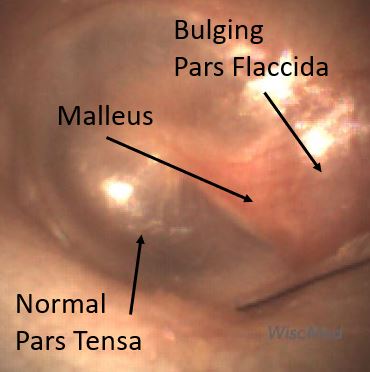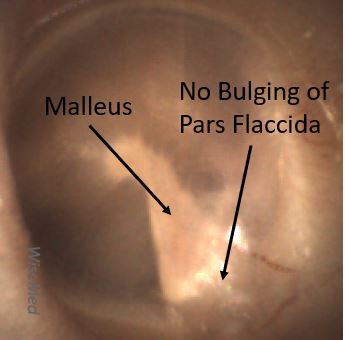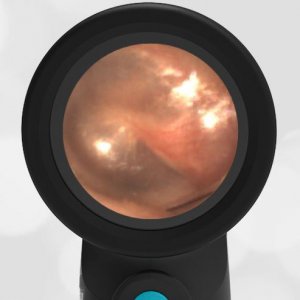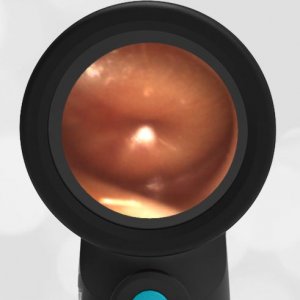
Bulging Pars Flaccida
A two-and-a-half-year-old female is brought into the pediatric clinic by her mother. The child has had two days of viral symptoms including cough and congestion and now has a fever of 39 C. The child has been generally healthy with no history of ear infections. Multiple children at daycare have had similar symptoms. On exam, the child looks ill without being toxic. She is alert to activities in the room. Her lungs are clear. She has a cough and rhinorrhea. The following image of her right ear is obtained. What is your diagnosis?
The child has bulging of the pars flaccida portion of her tympanic membrane (ear drum) without evidence of acute otitis media.
This is a common clinical pediatric presentation. A collection of symptoms that most likely represent a viral infection of the upper respiratory system, but that could also lead to acute otitis media (AOM, middle ear infection). This case is particularly interesting because there is a clear bulging of the pars flaccida portion of the tympanic membrane (ear drum).
- Bulging Pars Flaccida
- Normal
Recall that the pars flaccida is the “loose part” of the ear drum, and therefore the first to react to increased pressure in the middle ear. This can be caused by a crying, upset, breath-holding child. The Eustachian tube ventilates the middle ear space to the posterior nasal pharynx. You have observed this yourself when your ears pop in an airplane during descent. At the same time, the Eustachian tube can also pressurize the middle ear space if lung pressure is applied against a closed mouth and nose, known as the Valsalva maneuver. Children are good at performing the Valsalva maneuver when upset. The maneuver communicates the increased pressure in the mouth to the middle ear where it is externally observed as bulging of the pars flaccida.
The diagnosis of AOM relies on bulging of the complete tympanic membrane, the “angry donut.” Compare the image from this weeks case to an image of acute otitis media. Note that in the AOM case, the complete tympanic membrane is bulging and it is not possible to identify the malleus bone.
- Bulging Pars Flaccida
- Acute Otitis Media
It is unlikely that this case represents developing acute otitis media. Developing AOM would generally include other signs of middle ear infection in addition to pars flaccida bulging such as air-fluid levels and purulence in the middle ear space. It’s possible, but unlikely, that this could be residual bulging from resolving AOM. See this Wispr University article for images of developing and resolving AOM. Most likely the observed bulging of the pars flaccida is due to a breath-holding child.
The child was diagnosed with a viral syndrome and the mother was given careful return instructions. Antibiotics were not indicated.
WiscMed thanks Dr. Daniel Lapidius of Pediatric Affiliates for this interesting case. WiscMed also thanks Dr. Michael Poole of Georgia Ear, Nose, and Throat for his consult on this case. WiscMed highly recommends Dr. Poole’s book “Otitis: The Expert’s Diagnostic Guide.” Currently available at no cost on Apple Books.
Here is the complete video exam:
Complete exam video












































































































































































































